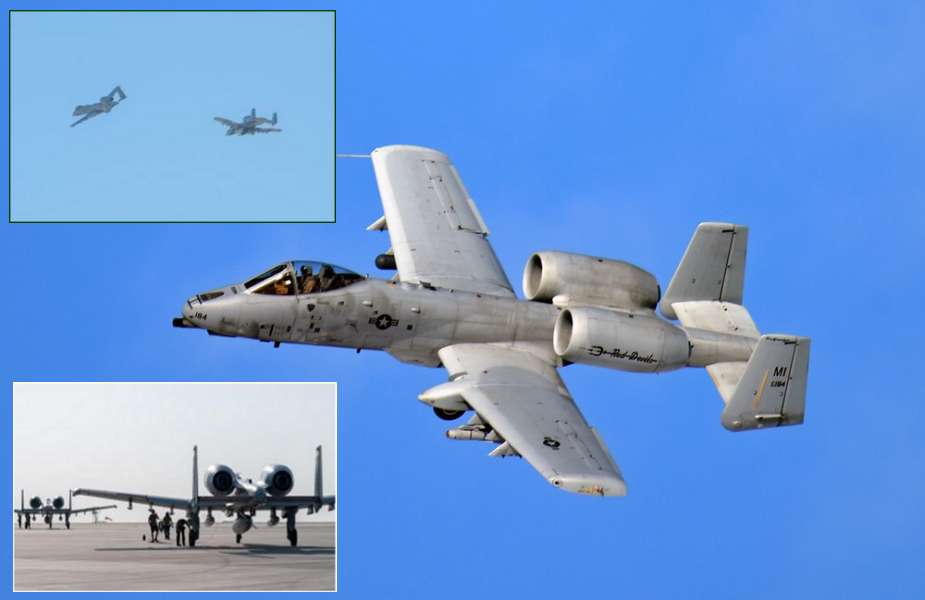Breaking news
US strengthens military support to Israel by deploying second Squadron of A-10 Warthogs.
In response to recent Hamas attacks against Israel, the United States has taken significant steps to strengthen its military support for Israel and to strengthen its military presence in the region. A key initiative in this response is the deployment of a second squadron of A-10 Warthog ground attack aircraft, also known as the Thunderbolt II. This development was revealed through a tweet on the US Central Command's Twitter account on October 12, 2023.
Follow Air Recognition on Google News at this link
 The 354th Fighter Squadron with its A-10 Thunderbolt IIs arrived in the region to reinforce the U.S. military posture (Picture source: US DoD)
The 354th Fighter Squadron with its A-10 Thunderbolt IIs arrived in the region to reinforce the U.S. military posture (Picture source: US DoD)
The 354th Fighter Squadron with its A-10 Thunderbolt IIs arrived in the region to reinforce the United States' military posture. This strategic decision complements the already existing presence of A-10s from the 75th Fighter Squadron in the region.
The A-10 Thunderbolt II, colloquially nicknamed the Warthog, is a twin-engine, straight-wing aircraft developed by Fairchild-Republic in the early 1970s. It is specifically designed for close air support missions, including tank attacks, armored vehicles, and other ground targets with limited air defenses. The centerpiece of the A-10 is its impressive 30mm GAU-8 Avenger autocannon, which makes it a formidable ground combat machine.
What sets the A-10 apart is its simplicity and robustness. It is capable of operating from rudimentary airfields, and its design includes titanium armor that allows it to withstand direct air defense hits, such as those from the fearsome ZSU-23-4. Even in the event of significant damage, the A-10 is designed to return safely to base, even if one of its two turbofan engines is still functional.
Over the years, the A-10 has benefited from constant upgrades to improve its operational capabilities. Notable improvements included the adoption of the Pave Penny laser receiver pod in 1978, which provided faster and more accurate target identification from designator lasers. In 1980, the A-10 began receiving an inertial navigation system for improved navigation accuracy. In 2005, the entire A-10 fleet was modernized under the Precision Engagement program, including an improved fire control system (FCS), electronic countermeasures (ECM), and bomb targeting intelligence. These improvements have allowed the A-10 to remain a powerful and effective force in its ground attack mission.
The deployment of this second squadron of A-10 Warthogs aims to further strengthen the response capacity of the United States and its allies in the face of escalating tensions in the Middle East. Gen. Michael “Erik” Kurilla, commander of U.S. Central Command, stressed that the arrival of these highly capable forces in the region sends a strong signal of deterrence to any entity hostile to Israel that might consider taking advantage of the situation.
At the beginning of the year 2023, the U.S. Air Force made the decision to deploy A-10 aircraft to the Middle East due to Iran's aggressive actions in the Persian Gulf. These attack aircraft arrived in the region alongside the destroyer USS Thomas Hudner (DDG 116), which is part of the carrier strike group led by the USS Gerald R. Ford. They were joined by fifth-generation F-35 Lightning II fighters and several other warships.
As the situation continues to evolve, the A-10 Thunderbolt II is once again demonstrating its value as a critical tool in maintaining regional stability and defending U.S. and allied interests. Its withdrawal from service, which has been considered several times, is currently not planned until at least 2030.



















